How to Make a Subway Map with John Tauranac
Hear from an author and map designer who has been creating maps of the NYC subway, officially and unofficially, for over forty years!


We’re doing a bunch of fun events with Will Ellis, the author of Abandoned NYC and Untapped Cities columnist, over the next few months. We hosted the first book talk when Abandoned NYC was released, and we’ll be hosting it again on February 25th at WeWork West Broadway. Tickets are also going fast to his guided tour of Dead Horse Bay in March. He’s curated this list of New York City’s abandoned hospitals for us, a remnant of a darker medical past when the diseased and undesirables were placed far from civilization.
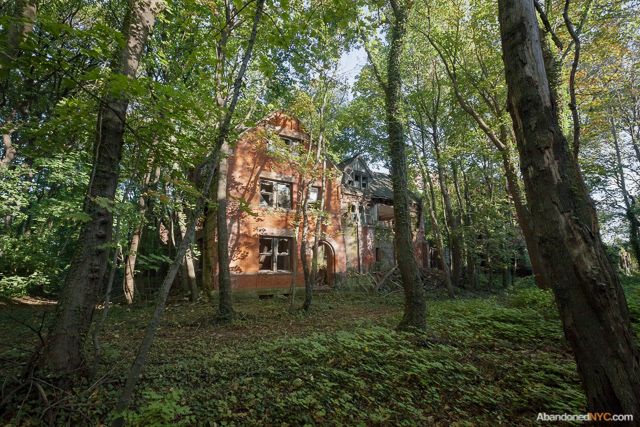
North Brother Island has a mythic status amongst urban explorers because it ranks among the more difficult to access, with its proximity to Rikers Island and the heavy vegetation that canvases the island in the warmer months. Will Ellis and Christopher Payne, who has a wonderful photography book about North Brother Island, visited the island legally through the NYC Parks Department.
Established as a city hospital for quarantinable diseases in 1885, it became a disreputable rehab center for adolescent drug addicts prior to its abandonment in the 1960s. To add to the intrigue, the island was the site of a catastrophic shipwreck and the residence of the notorious Typhoid Mary. Today, it’s kept in its crumbling state because it’s a bird sanctuary.
See additional photographs of North Brother Island by Christopher Payne and more from Will Ellis.

Photo by Abandoned NYC
Throughout its history, the grounds of the Staten Island Farm Colony were often associated with society’s ‘unwanted’. The colonial farm era in the 19th century witnessed a bout of construction developments catered to housing the poor, infirm, mentally ill and developmentally disabled. Initially, the Farm Colony housed a collective of farmhouses that rehabilitated New York City’s aging poor, until they were replaced by the dormitory structures we see today. Not only where these facilities overcrowded, the employees and staff that worked on the Farm Colony were habitually intoxicated.
In November 2014, the Landmarks Preservation Commission approved a plan to redevelop the Farm Colony into senior housing and retail.
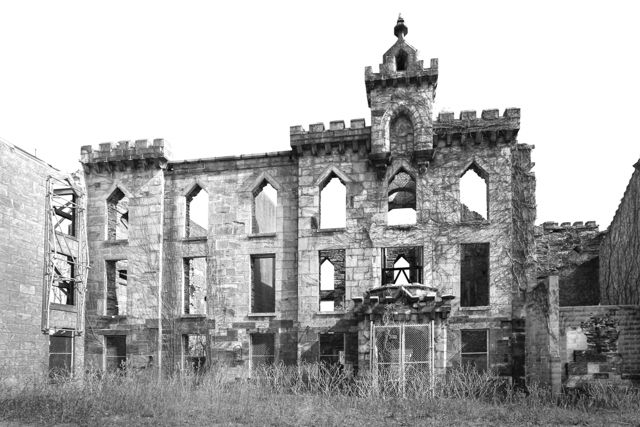
Photo by Abandoned NYC
The smallpox hospital, completed in 1856 in a Gothic-revival style, was designed by James Renwick Jr., who also designed St. Patrick’s Cathedral on Madison Avenue. For the 19 years the hospital operated (until 1875), approximately 7,000 patients were treated here. In 1875, the hospital relocated to North Brother Island because Blackwell’s Island had become too populated and the building was converted into a nurses dormitory. By the 1950s, the original smallpox hospital was abandoned.
In 1975, the Landmarks Preservation Committee declared the structure a city landmark, and the only landmarked ruin in New York City. Today, you can visit the ruin (not inside, but along the sides) through a walk in South Point Park, just before the entrance to FDR Four Freedoms Park.
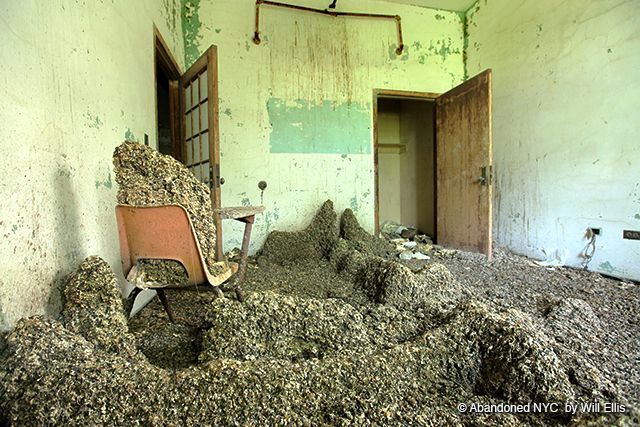
Creedmoor Psychiatric Center’s Building 25 was once a haven for New York City’s cast-out mentally ill, but today it houses a much more reviled and equally misunderstood breed of New Yorker–they’re pigeons, and you won’t believe what they’ve done with the fourth floor. The sprawling Creedmoor campus was constructed in 1912 in Queens Village as the Farm Colony of Brooklyn State Hospital.
By 1960, Creedmoor’s population swelled from 150 in 1918 to over 7,000. But with the development of antipsychotic medications came a trend toward deinstitutionalization. Amazingly, the campus continues to operate today, housing only a few hundred patients and providing outpatient services. Many of the buildings at Creedmor have been sold off. Others, like Building 25, lie fallow.

Photo by Abandoned NYC
A floundering medical complex sits on a 20-acre campus in Stapleton on the North Shore of Staten Island. Today, eight of Bayley Seton Hospital’s twelve buildings lie abandoned, the largest being the old Nurses’ Residence at its southeast corner. The grounds of BSH house Staten Island’s first hospital, an historic colonnaded structure built in the 1830s to serve ailing retired naval and merchant sailors, appropriately named “the Seamen’s Retreat.” The facility passed hands multiple times, finally to the Salvation Army who has failed to fundraise the amount needed to redevelop the site into senior housing.
Twelve foot chain link fences have been placed along the perimeter of the Salvation Army property, but the site is otherwise untouched. Fenced-off and boarded-up, a former Nurses’ Home ages in secret. The FOX show Gotham uses Bayley Seton Hospital as the setting for Arkham Asylum.

Photo by Abandoned NYC
Fort Totten sits on a far-flung peninsula of the Long Island Sound, forming the northeast corner of Queens. The grounds of this defunct military installation turned underfunded public park are home to over 100 historic buildings representing a series of changes that have taken place over the area’s quiet 200 year history. Unfortunately, the majority of these stuctures have been disused for decades, and many are in a state of progressive collapse. One of these buildings is the army hospital, pictured above. Ellis tells Untapped Cities that it was one of the photographs in which he later questioned his sanity stepping into such a dilapidated structure.
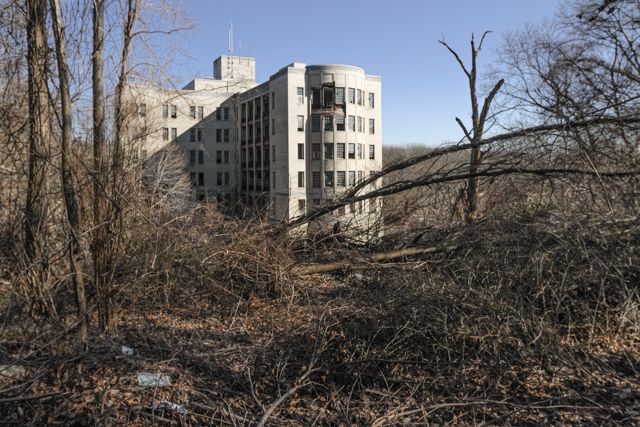
Photo by Abandoned NYC
Seaview Hospital was once the largest tuberculosis sanatorium in the country, now listed on the U.S. National Register of Historic Places and is also a U.S. Historic District and New York City landmark. The historic district, which was developed next to the Staten Island Farm Colony, includes 37 buildings and today a few organizations have returned to operate from within the grounds, including a rehab center, volunteer firefighting organization and volunteer ambulance service.
Designed by Raymond F. Allmiral, the architecture and layout reflected the latest in thought about the treatment of tuberculosis, including light, cross-ventilation, access to the outdoors, and thought towards medical operational efficiency.

Photo by Abandoned NYC
For 124 years, a castle with many names loomed over the quiet neighborhood of Thompkinsville, Staten Island. Named for a doctor who dedicated his life to the treatment of the poor, the Samuel R. Smith Infirmary was founded in 1863 as the borough’s first private hospital. Principally funded by lavish charity balls, the organization was the pet project of the borough’s high society, known as the “Pride of Staten Island.” By the turn of the twentieth century, the Infirmary had outgrown its former home, and the cornerstone was laid for the new building.
Though the Smith Infirmary was established for the poor, it soon opened its doors to the general public and was renamed Staten Island Hospital in 1916. Many notable actors, lawyers, and political figures were treated there, among more mysterious cases.
On an early March morning in 2012 while most of the island slept, wrecking balls converged at the Frost Memorial Tower of the old Samuel R. Smith Infirmary. In a matter of hours, the hospital was brought to the ground. Dozens gathered to watch her fall.
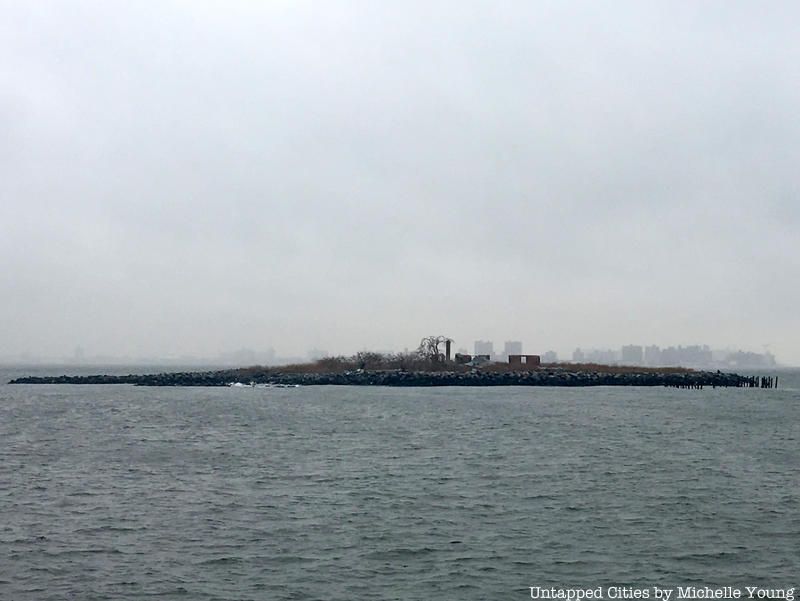
East of Staten Island’s South Beach, the Hoffman and Swinburne Islands were constructed from landfill in the 1870s, and served as designated quarantine stations for arriving immigrants who were found to be suffering from contagious diseases, similar to the Ellis Island Southside Hospitals. To prevent the occurrence of a deadly epidemic, a concrete wall barricades each island. Years later, the islands were also used as military training centers. They’ve been off-limits to the public since 1947. For the benefit of avian species, the National Park Service currently manages the eleven-acre Hoffman Island and four-acre Swinburne Island as part of the Staten Island Unit of the Gateway National Recreation Area.
Get a copy of Will Ellis’ book Abandoned NYC and join us for a talk and book signing on February 25th at WeWork West Broadway. This article written collectively by Will Ellis and the Untapped Cities staff.
Subscribe to our newsletter